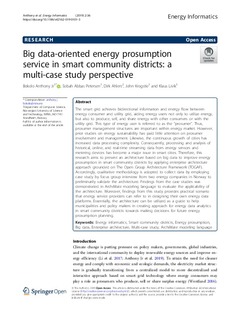| dc.contributor.author | Bokolo, Anthony Junior | |
| dc.contributor.author | Petersen, Sobah Abbas | |
| dc.contributor.author | Ahlers, Dirk | |
| dc.contributor.author | Krogstie, John | |
| dc.contributor.author | Livik, Klaus | |
| dc.date.accessioned | 2019-12-05T07:35:34Z | |
| dc.date.available | 2019-12-05T07:35:34Z | |
| dc.date.created | 2019-12-03T21:21:14Z | |
| dc.date.issued | 2019 | |
| dc.identifier.citation | Energy Informatics. 2019, 2 (1), 1-26. | nb_NO |
| dc.identifier.issn | 2520-8942 | |
| dc.identifier.uri | http://hdl.handle.net/11250/2631836 | |
| dc.description.abstract | The smart grid achieves bidirectional information and energy flow between energy consumer and utility grid, aiding energy users not only to utilize energy, but also to produce, sell, and share energy with other consumers or with the utility grid. This type of energy user is referred to as the “prosumer”. Thus, prosumer management structures are important within energy market. However, prior studies on energy sustainability has paid little attention on prosumer involvement and management. Likewise, the continuous growth of cities has increased data processing complexity. Consequently, processing and analysis of historical, online, and real-time streaming data from energy sensors and metering devices has become a major issue in smart cities. Therefore, this research aims to present an architecture based on big data to improve energy prosumption in smart community districts by applying enterprise architecture approach grounded on The Open Group Architecture Framework (TOGAF). Accordingly, qualitative methodology is adopted to collect data by employing case study by focus group interview from two energy companies in Norway to preliminarily validate the architecture. Findings from the case studies was demonstrated in ArchiMate modeling language to evaluate the applicability of the architecture. Moreover, findings from this study provides practical scenario that energy service providers can refer to in designing their own energy data platforms. Essentially, the architecture can be utilized as a guide to help municipalities and policy makers in creating approach for energy data analytics in smart community districts towards making decisions for future energy prosumption planning. | nb_NO |
| dc.language.iso | eng | nb_NO |
| dc.publisher | Springer Nature | nb_NO |
| dc.rights | Navngivelse 4.0 Internasjonal | * |
| dc.rights.uri | http://creativecommons.org/licenses/by/4.0/deed.no | * |
| dc.title | Big data-oriented energy prosumption service in smart community districts: a multi-case study perspective | nb_NO |
| dc.type | Journal article | nb_NO |
| dc.type | Peer reviewed | nb_NO |
| dc.description.version | publishedVersion | nb_NO |
| dc.source.pagenumber | 1-26 | nb_NO |
| dc.source.volume | 2 | nb_NO |
| dc.source.journal | Energy Informatics | nb_NO |
| dc.source.issue | 1 | nb_NO |
| dc.identifier.doi | 10.1186/s42162-019-0101-3 | |
| dc.identifier.cristin | 1756295 | |
| dc.description.localcode | Open Access This article is distributed under the terms of the Creative Commons Attribution 4.0 International License (http://creativecommons.org/licenses/by/4.0/), which permits unrestricted use, distribution, and reproduction in any medium, provided you give appropriate credit to the original author(s) and the source, provide a link to the Creative Commons license, and indicate if changes were made. | nb_NO |
| cristin.unitcode | 194,63,10,0 | |
| cristin.unitcode | 194,61,50,0 | |
| cristin.unitname | Institutt for datateknologi og informatikk | |
| cristin.unitname | Institutt for arkitektur og planlegging | |
| cristin.ispublished | true | |
| cristin.fulltext | original | |
| cristin.qualitycode | 1 | |

